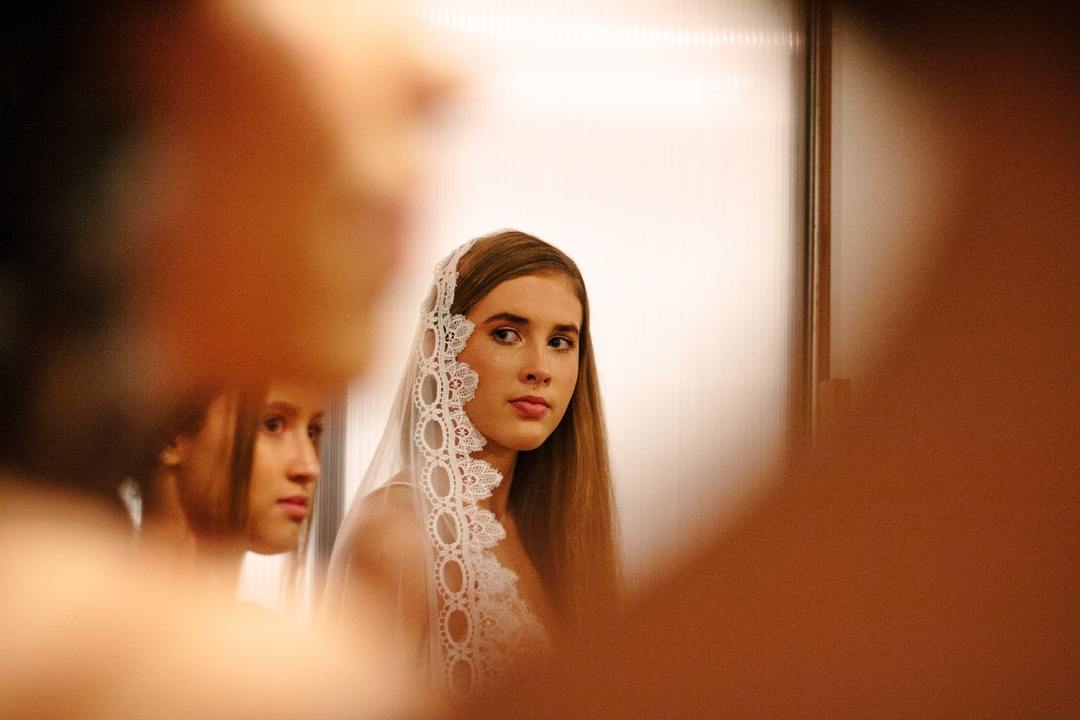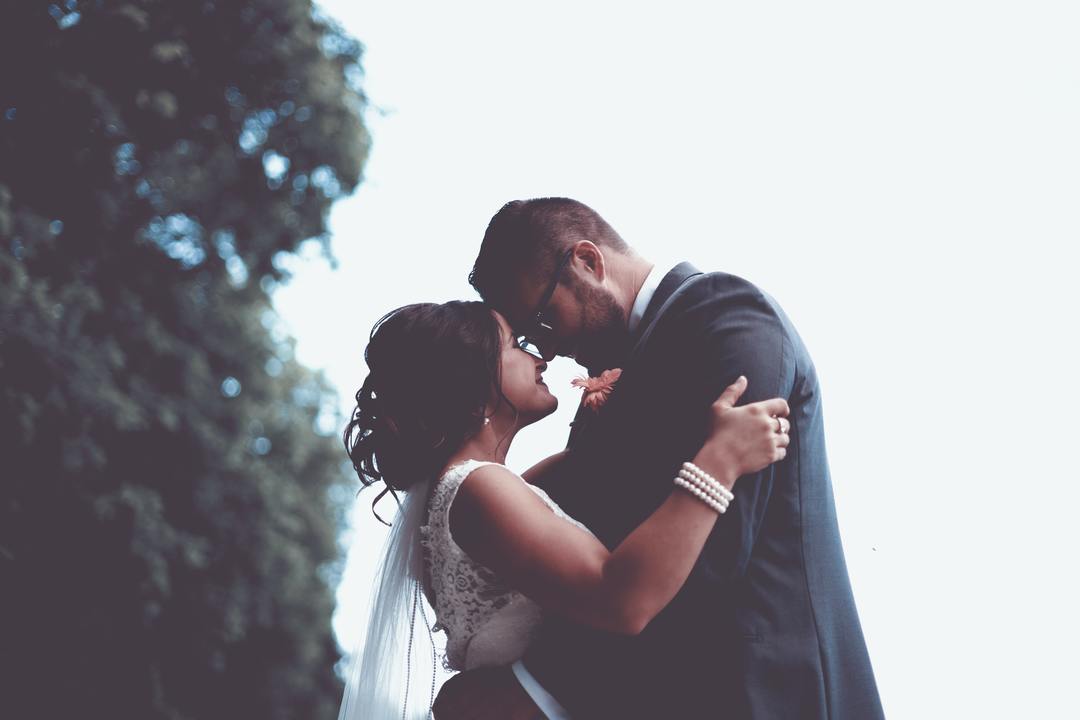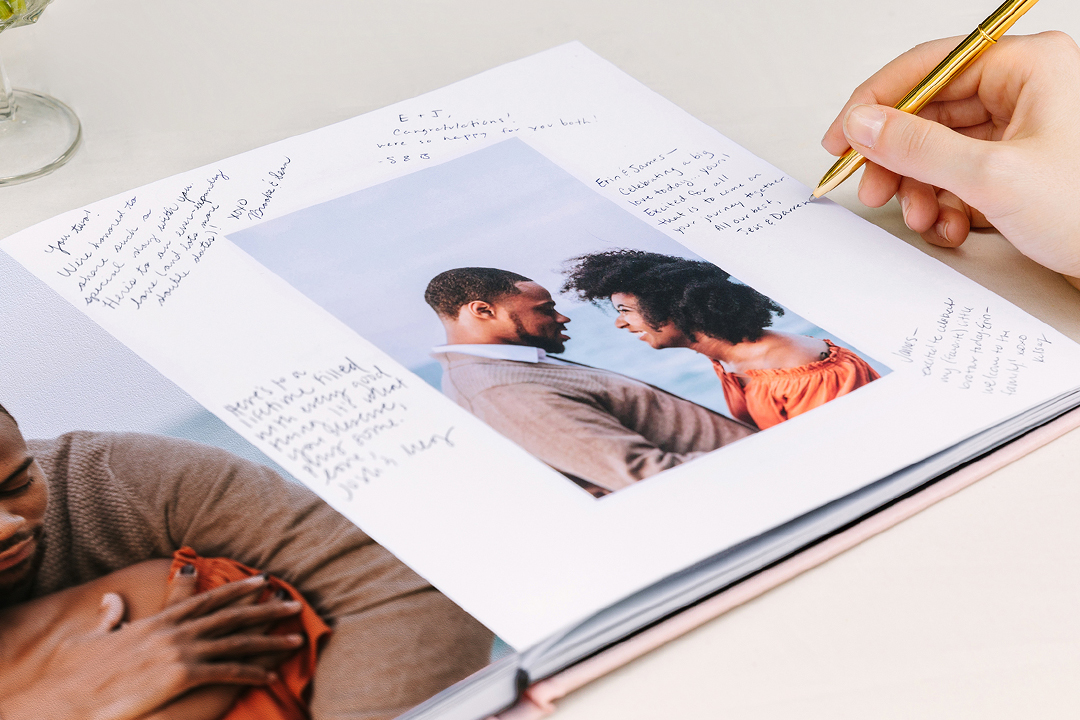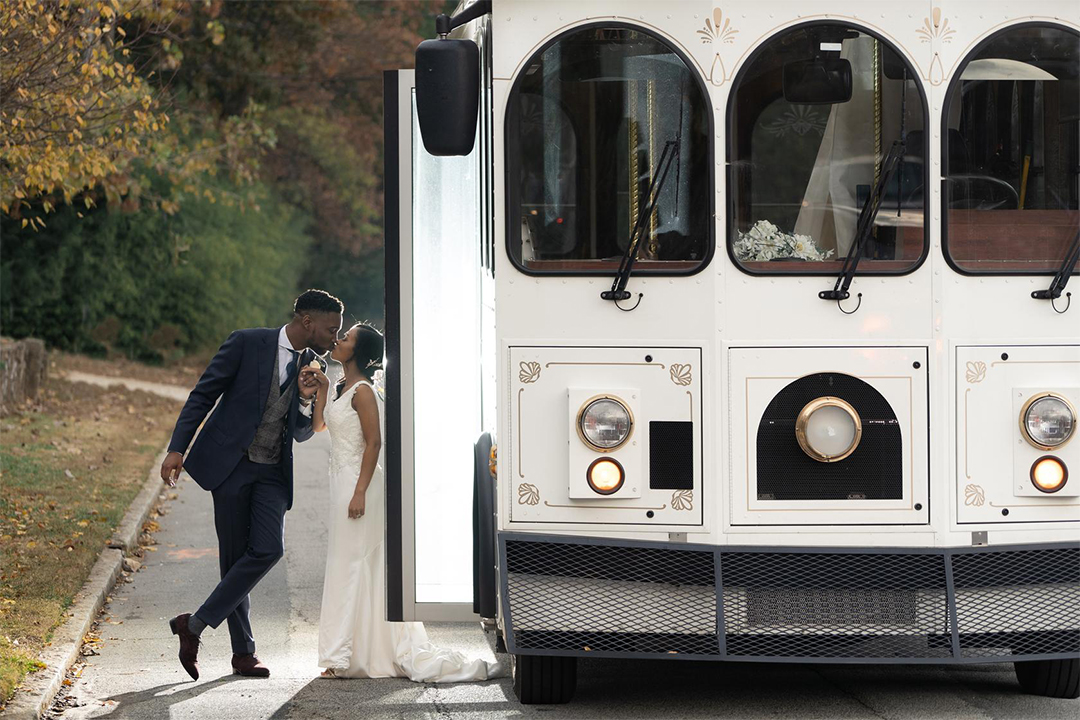- Expert advice/
- Wedding planning 101/
- Wedding day/
- A Guide to the Ideal Wedding Photography Timeline
- Wedding day
A Guide to the Ideal Wedding Photography Timeline
Your wedding photos are an important part of your big day. Learn more about how to plan a timeline that ensures you will have plenty of time to get the photos you want.
Last updated February 5, 2024

Throughout your wedding planning, you’ve probably put together a timeline of events for your wedding day. You’ve figured out when to start getting ready in the morning, when to leave for the venue, how long the ceremony will take, and when you will be announced to your guests at the reception. But have you incorporated a timeline for your photos to ensure you get all the shots you want?
Many couples don’t realize how much time is needed to get wedding photos that look effortlessly beautiful. So, how long do wedding photos take? Let’s take a closer look at the details of your wedding photography timeline.
How to Plan Your Wedding Photos
Depending on the types of portraits you want your photographer to take (different wedding photographers have different styles!), it will probably take you at least two hours to get all the shots. However, the good news is that the photos usually aren’t taken all at once, and the time is broken up throughout your day.
Most photographers say you need about 30 minutes for wedding party portraits, 30 minutes for family portraits (close family only), and 45 minutes for couple portraits. Just remember: These timeframes can contract or expand, depending on the size of your wedding party and family, as well as the specific types of shots you want. For specifics, speak to your wedding photographer about how long they’ll need to take all the different shots you have in mind, plus how you might be able to save time. Here are some of the details you should consider as you plan the photos you want.
1. Pick Who You’ll Include in Formal Portraits

Of course, the focus of your wedding photos will be you and your spouse. However, you will probably want to have formal portraits taken of you with your wedding party, as well as family wedding photos. Deciding who you will include in this session can significantly impact how long your wedding photos will take. Your parents may try to convince you that you should have a formal portrait with all of your relatives, but remember that the more photos you take, the longer you will be kept away from your celebration. A good rule of thumb is to keep formal portraits limited to about 15 different groupings, including your wedding party, immediate family, and possibly a few important relatives. To help you make this decision, your photographer may be able to provide you with a list of suggested formal portrait groupings, so you know how to edit wedding photos based on your needs.
2. Decide If You’ll Do a “First Look”

An increasingly popular photo that couples are choosing to incorporate is a “first look.” The first look wedding photo This photo captures the first time the couple sees each other on their wedding day, usually wearing their wedding attire and occurring before the ceremony.
Many photographers suggest this option, because it gives you the opportunity to take formal portraits before the ceremony, allowing you to enjoy the cocktail hour with your guests. If you choose the alternative—to stick with tradition and wait to see each other at the ceremony—you will likely spend your entire cocktail hour taking portraits. This choice can significantly impact your wedding photography timeline, so make sure you and your partner have come to a decision before finalizing your plans.
3. Pick Your Locations
Once you’ve decided who’ll be in your photos and if you’ll be doing a “first look,” choose where you will be taking the photos. The most obvious and easiest locations will be your ceremony and reception venues, but you aren’t limited to these.
If the hotel where you’re getting ready has beautiful scenery, you might decide to have some portraits taken there, such as the bridal party or groomsmen photos. However, you might have other specific places of importance, like a local park or a specific neighborhood in your city. While this is definitely an option, you will need to plan for the extra time and transportation required to travel to and from those locations on your big day.
Your Wedding Photo Timeline
After you’ve figured out all the details of your wedding photos, you’ll want to work with your photographer (or wedding planner) to create a fully documented schedule of your wedding day, including the timeline for your photos. And don’t forget: It’s useful to add five-minute buffers throughout the day to leave room for any last-minute changes. You will also want to include any travel time to move between locations.
Once you’ve established your timeline, make sure that anyone who will be included in photos is aware of the schedule, plus has all relevant details. The last thing you want is to be waiting on a relative to show up for photos, so encourage all your important people to stick to the timeline you give them.
Sample Timelines
To help you out, we put together two sample wedding photo timelines (including a wedding photo list!). The first is for a couple doing a “first look” session, while the second is for a couple going the more traditional route. Seeing these schedules next to one another may help you decide what you’d like to do for your wedding based on the impact that session can have on your overall timeline.
Timeline With First Look
11:45 AM - Wedding Photographer’s Arrival
From a photo perspective, the day can’t start until the photographer arrives—which is why the first item on any wedding day photography timeline is the photographer’s arrival. At this point, the wedding photographer arrives on site and prepares to start snapping photos.
12:00 - 2:00 PM - Getting Ready Photos
During the next phase, the couple is separated, getting ready for the ceremony with their wedding party. These photos are often candid.
During this time, the wedding photographer may take a variety of shots, including:
-
The groom getting dressed with the groomsmen
-
The bride getting ready with the bridesmaids
-
The hair stylist creating the bride’s wedding day hairstyle
-
Close-ups of the makeup artist doing the bride and bridesmaids’ makeup
-
Detail shots (for example, rings, wedding shoes, bouquets, wedding invitations, etc.)
If the wedding photographer has a second shooter, they may split up—with each photographer taking photos of one half of the couple and their bridesmaids and/or groomsmen.
Location ideas: Wherever the bride and/or groom is getting ready—for example, their home, the wedding venue, or a hotel
2:15 - 3:00 PM - First Look and Couple Portraits
If a couple opts to do a first look, then the photographer will get the opportunity to shoot them pre-ceremony. First look photos generally include:
-
Portrait sessions for both people (for example, bridal portraits and groom portraits)
-
The couple seeing each other in their full wedding looks for the first time
-
Couples portraits
Location ideas: Somewhere at or near the wedding venue—either outdoors (for example, in a garden or next to the ocean) or indoors (for example, in a hallway or underneath an entrance)
3:15 - 3:45 PM - Wedding Party Portraits
After the first look, it’s time to tackle wedding party photos. This may include:
-
The bride with all of her bridesmaids
-
The bride with each bridesmaid
-
The bride with the maid of honor
-
The groom with all of the groomsmen
-
The groom with each groomsmen
-
The groom with his best man
-
The couple with the entire wedding party
-
The bride with her partner’s side of the wedding party
-
The groom with his partner’s side of the wedding party
Location ideas: Outside the wedding venue, at an off-site location with a scenic background
4:30 - 5:00 PM - Wedding Ceremony
It’s time to get married! During the wedding ceremony, the photographer will likely snap a variety of photos, including:
-
The ceremony location
-
Detail shots (for example, the ceremony programs, the flowers, the arbor, etc.)
-
Guests arriving at the ceremony start time
-
The wedding party walking down the aisle
-
Family members walking down the aisle
-
The bride and/or groom (or brides and grooms) walking down the aisle
-
The officiant
-
Any friends or family that share readings during the ceremony
-
The couple exchanging wedding vows
-
The couple walking down the aisle after getting married
Location ideas: At the ceremony site
5:10 - 5:40 PM - Family Portraits
After the ceremony, the wedding photographer will take formal portraits of the couple and their families. This may include:
-
The bride with her parents
-
The groom with his parents
-
The couple with one set of parents
-
The couple with the other set of parents
-
The couple with both sets of parents
-
The bride with her siblings
-
The groom with his siblings
-
The couple with one set of siblings
-
The couple with both sets of siblings
-
The bride with her immediate family
-
The groom with his immediate family
-
The couple with one partner’s immediate family
-
The couple with the other partner’s immediate family
-
The couple with both of their immediate families
-
The bride with her grandparents
-
The groom with his grandparents
-
The couple with one set of grandparents
-
The couple with the other set of grandparents
-
The couple with both sets of grandparents
-
Additional family photos as necessary (for example, photos with aunts, uncles, and/or cousins)
Location ideas: At the ceremony site, somewhere scenic/quiet at the wedding venue that’s away from cocktail hour (for example, a garden or ballroom)
5:10 - 6:20 PM - Cocktail Hour
If your wedding photographer has a second shooter, they will often snap photos during cocktail hour while the main photographer handles family photos. This may include:
-
Guests mingling at cocktail hour
-
Photos of your signature wedding cocktails
-
Detail shots (for example, cocktail napkins, signage and decor, etc.)
Location ideas: At the cocktail hour site
6:30 PM - Wedding Reception
Your wedding reception is full of moments that you’ll want to turn into memories—and your wedding photographer will be on hand to ensure that happens. Some wedding reception photos your photographer will likely want to capture include:
-
The couple’s grand entrance
-
Guest table photos
-
The couple’s first dance
-
Parent dances
-
Toasts and speeches
-
Guests dancing on the dance floor
-
The garter toss and/or bouquet toss
-
Cake cutting
-
The couple’s exit
-
Detail shots (for example, centerpieces, decor, table signage, gift table, etc.)
Location ideas: At the wedding reception site
Timeline Without First Look
12:00 - 2:00 PM - Getting Ready Photos
Same as above
2:15 - 3:30 PM - Separate Wedding Party and Family Portraits
If a couple opts not to do a first look, the wedding photographer can’t do group photos before the ceremony—but they can do separate wedding party and/or family portraits. This may include:
-
The bride with her bridesmaids
-
The bride with each bridesmaid
-
The bride with her maid of honor
-
The bride with her parents
-
The bride with her siblings
-
The bride with her immediate family
-
The bride with her grandparents
-
The bride with any additional family as necessary (for example, aunts, uncles, or cousins)
-
The groom with his entire family
-
The groom with his groomsmen
-
The groom with each groomsmen
-
The groom with his best man
-
The groom with his parents
-
The groom with his siblings
-
The groom with his immediate family
-
The groom with his grandparents
-
The groom with any additional family as necessary (for example, aunts, uncles, or cousins)
-
The groom with her entire family
4:30 - 5:00 PM - Wedding Ceremony
Same as above
5:15 - 6:15 PM - Couple and Group Portraits
If there’s no first look, the couple will take both couple’s and group portraits after the wedding ceremony. This may include:
-
Photos of the couple
-
The couple with their entire wedding party
-
The couple with one set of parents
-
The couple with the other set of parents
-
The couple with both sets of parents
-
The couple with one set of siblings
-
The couple with the other set of siblings
-
The couple with both sets of siblings
-
The couple with one person’s immediate family
-
The couple with the other person’s immediate family
-
The couple with both of their immediate families
-
The couple with one set of grandparents
-
The couple with the other set of grandparents
-
The couple with both sets of grandparents
-
The couple with one person’s entire family
-
The couple with the other person’s entire family
-
The couple with both of their entire families
5:15 - 6:20 PM - Cocktail Hour
Same as above
6:30 PM - Wedding Reception
Same as above
As you can see from the timelines above, the “first look” photos can give you more time to enjoy being with your guests after the ceremony. However, if you choose to stick to a more traditional timeline and wait to see each other at the ceremony for the first time, you will still be able to take all the photos you want. Ultimately, the decision is up to you as a couple and what works best for your wedding day.
Things To Consider When Developing Your Wedding Day Photography Timeline
Need more insights in to how to navigate your wedding day timeline? Here are a few things to keep in mind:
-
Stick to the timeline... Your wedding photographer has a timeline for a reason! The timeline is created to ensure they have enough time to capture all of the shots you’ll want from your wedding day—so make their lives easier by sticking to the timeline as much as possible.
-
...but also be flexible. Ideally, you’ll stick to your wedding photography timeline—but things happen that may throw you off course (for example, it may take you longer to get ready than you originally planned or there may be a delay in getting to your first look location). Make sure to stay flexible and allow your photographer to switch things up as necessary.
-
Keep awkward moments to a minimum. Your wedding photographer is there to capture happy moments—not awkward ones. Think about any potential awkward interactions—and make a plan to deal with them. (For example, if you have divorced parents that can’t be in the same room, make sure to let your photographer know so she can schedule those family portraits separately.)
-
Make sure to account for transportation time. If you’re taking photos at multiple locations, make sure to build transportation time into your timeline.
-
Don’t be afraid to ask for a redo. If something feels off about your photography sessions—for example, you don’t like where you’re snapping your bridal party photos or the sky is too dark and cloudy for your liking—don’t be afraid to ask your photographer to either retake the photos or rethink their approach and offer other options.
While it may be tempting to figure out your wedding photos on a whim throughout your wedding day, ensuring you get all the shots you want will require some planning. Start by deciding who you want to take photos with and where they will be taken. Then, as a couple, choose whether or not you want a “first look” photo. Work with your photographer to get a better sense of how long they need to get high-quality shots. And finally, create a detailed timeline for your wedding day, then share it with all the appropriate people. Taking these steps will ensure your big day runs smoothly, so you can enjoy being in the moment—and enjoy getting back your wedding photos after your big day. (Don’t forget to ask about turnaround time!)
Up next for you

41 Questions to Always Ask Wedding Photographers
Inspiration
You’ll be reminiscing on your wedding photos for years to come. These questions to ask wedding photographers will help you hire someone whose style you love!

What to Include in a Wedding Memory Book
Inspiration
Wedding memory books are a great way to keep everything from your big day in one place. Learn what to include to make this special keepsake.

Wedding Transportation Ideas and Etiquette for Your Big Day
How To
How are you and your guests going to travel from point A to point B on your big day? This guide has the 411 on wedding transportation.

DIY Guest Book Templates
How-To
Thinking of creating your own wedding guest book? Check out some of our printable templates to help you get started.
- Expert advice/
- Wedding planning 101/
- Wedding day/
- A Guide to the Ideal Wedding Photography Timeline
Find even more wedding ideas, inspo, tips, and tricks
We’ve got wedding planning advice on everything from save the dates to wedding cakes.
